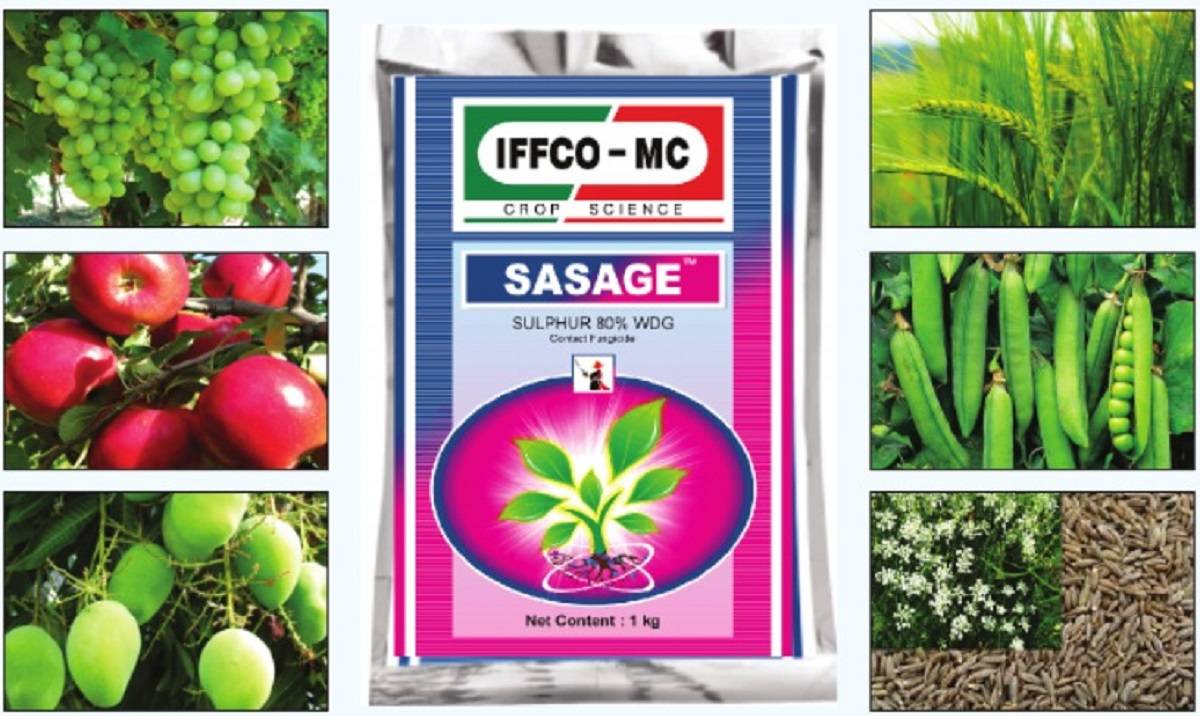
Fungicides are substances that either eliminate or stop the development of fungi and their spores. Fungicides have a variety of actions, but the major fungicides have a damaging effect on the membranes of fungi or prevent them to spread.
Broad-spectrum fungicides are typically contact-based, multi-sited fungicides that are not only effective against diseases that are closely related to it, but also against pathogens that are unrelated to it. Contact fungicides only protect the plant where the spray is placed because they are not absorbed into the plant tissue.
Fungal disease management could be difficult sometimes and as a result, farmers must prioritize its management. Scientists and experts both usually recommend using fungicides to reduce production loss.
As a result, IFFCO and Mitsubishi Corporation established a joint venture to create Sasage, a contact fungicide with both preventative and curative properties.
Technical Name: Sulphur 80% WDG
Mode of Action: Fungicide with Contact Action
Description: It is a water-dispersible granule containing 80% sulphur as an active ingredient and balance adjuvants of 20% w/w.
Properties of using Sasage:
Sasage is a broad-spectrum contact fungicide that provides sulphur to plants and is preventive in nature.
Sasage is mainly used to prevent fungal diseases in plants and is made up of 80% sulphur as an active ingredient and 20 % w/w balance adjuvants. Rust, leaf spot and fungal spots are all controlled by Sasage. It prevents fungal disease in cumin, apple, grapes, mango, peas, cowpeas, and other plants.
Benefits:
-
Sasage is a flowable, micronized sulphur granule that is dust-free and simple to apply.
-
Sasage rapidly dissolves in water and spreads swiftly across the foliage, avoiding leaf burn.
-
It has a triple activity as a fungicide, micronutrient (sulphur), and miticide.
-
It has extended time of very lengthy control.
-
The application of Sasage protects fruit and leaf surfaces from spotting or scorching.
Features and USP:
-
Sasage is a brand of micronized sulphur granules that are dust-free, flowable, and simple to handle and measure.
-
Because to its rapid dispersion and great susceptibility in water, it does not burn.
-
It functions as an acaricide, micronutrient (Sulphur), and fungicide simultaneously.
-
Fruits and leaves are not stained or burned as a result of spraying.
Application and Method of Usage:
|
Crop |
Name of the disease |
Dosage per acre |
Waiting period (Days) |
|
|
Formulation(g) |
Dilution in Water(L) |
|||
|
Grapes |
Powdery mildew |
750-1000 |
300-400 |
24 |
|
Mango |
Powdery mildew |
750-1000 |
300-400 |
|
|
Wheat |
Powdery mildew |
1000 |
200 |
|
|
Cumin |
Powdery mildew |
750-1000 |
300-400 |
|
|
Cowpea, Guar, Peas |
Powdery mildew |
750-1000 |
300-400 |
|
|
Apple |
Scab |
750-1000 |
300-400 |
|
Directions for Use: Its usage is not advised for crops that are harmed by the use of sulphur, for fruits and vegetables of the Cucurbit family, as well as for apples, pears, and other types of fruit when the temperature is equivalent to or higher than 30 degrees Celsius or 85 degrees Fahrenheit. The product's use in these crops is harmful.
For further details visit: https://www.iffcobazar.in/









